The glass furnace is the most important thermal equipment in glass production. The throat, which channels the molten glass from the melting and clarification zone to the working zone, is one of the most critical components of the furnace. It largely determines the furnace‘s service life.
1. Traditional Glass Furnace Throat
2. Reflux-Free and Maintenance-Free Glass Furnace Throat
3. Operation of Reflux-Free and Maintenance-Free Throat
4. Application Prospects
1. Traditional Glass Furnace Throat
The traditional glass furnace throat requires high-grade refractory materials due to the severe impact of high-temperature erosion and spalling on product quality, production output, and production cycles. Limited by the flow rate of molten glass, the throat cross-section cannot be designed too small. Moreover, as high-temperature erosion and spalling gradually enlarge the throat cross-section, the glass flow rate slows down, causing significant reflux of molten glass and increased energy consumption. Additionally, to mitigate throat erosion and damage, high-power cooling equipment is required, leading to increased investment, energy consumption, and production costs.
1.1 Design of Traditional Glass Furnace Throat
The traditional glass furnace throat is generally designed according to the properties, color, quantity of the molten glass, and forming process requirements. The immersion depth of the throat is determined based on the properties of the molten glass (hard or soft) and its color (colorless or colored). The specifications and structural form of the throat are determined based on the quantity of molten glass (production output) and forming process requirements (material temperature).
1.2 Structural Forms of Traditional Throat
There are many structural forms of traditional throats, which are categorized based on process requirements into horizontal type (where the furnace bottom plane is the same as the throat bottom plane), raised horizontal type (where the throat bottom plane is higher than the furnace bottom plane), sunken horizontal type (where the throat bottom plane is lower than the furnace bottom plane), inclined type (inclined at 10°–20°), and extended type, among others.
1.3 Materials for Traditional Throat
Currently, the material used for glass furnace throats is primarily AZS-41 WS fused zirconia corundum bricks. To reduce throat erosion and extend furnace life, some colored glass furnaces and fiberglass furnace throats (or cover plates) use dense chrome blocks or chrome-zirconia corundum blocks. Some also embed surface-treated molybdenum plates on the throat surface, while others use high-value-added materials like platinum-rhodium alloys (for substrate glass, etc.) to encase the throat.
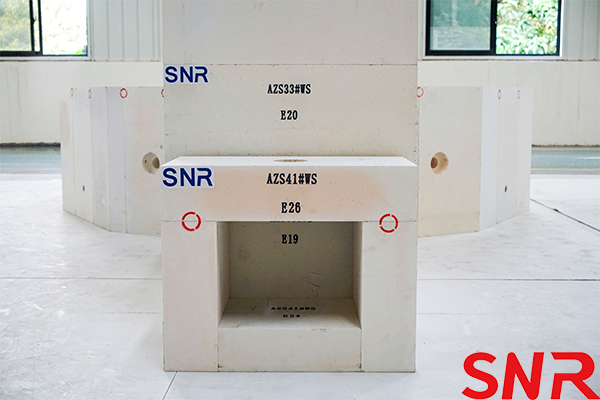

1.4 Operation of Traditional Throat
With advancements in refractory material manufacturing, the overall quality of throat blocks has significantly improved. Professional teams are responsible for throat construction, glass furnace heating, and operation. As a result, in the early stages of operation, the throat generally meets production needs.
However, as the furnace ages, problems with traditional throats gradually emerge. Due to slow erosion, the throat cross-section enlarges, the glass flow rate slows down, reflux increases significantly, and energy consumption rises. Additionally, as the throat cover plate erodes upward, the glass extraction depth becomes shallower (tending toward a shallower pool depth), reducing melting efficiency.
To meet forming requirements, melting process parameters (such as increasing melting temperature) must be adjusted, which further increases energy consumption. In later stages, as the throat cover plate thins, cooling measures must be intensified (adding cooling equipment), including pressurized water jackets or direct water cooling, to prevent leaks. This leads to increased heat dissipation from the molten glass, temperature fluctuations, and impacts on product output and quality, while also increasing operating costs. At this stage, dedicated personnel must monitor the throat 24/7.
1.5 Maintenance of Traditional Throat
Throat maintenance begins during glass furnace heating. It includes preventing throat deformation, block cracking, and blockages, as well as managing throat cooling. As the furnace ages, throat maintenance must be gradually intensified, especially in later stages, requiring significant maintenance efforts, additional personnel and monitoring equipment, and enhanced cooling measures. Despite this, material leakage accidents occasionally occur, causing equipment damage and even casualties.
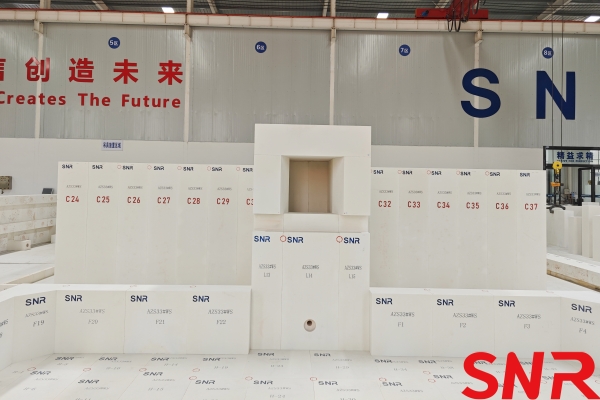

1.6 Defects of Traditional Throat
The defects of traditional throats include significant reflux of molten glass in later stages, changes in melting parameters affecting melting efficiency, temperature fluctuations in molten glass, high maintenance costs in later stages, and the risk of material leakage accidents.
The use of reflux-free and maintenance-free throat technology in glass furnaces ensures no reflux or maintenance throughout the entire furnace cycle, achieving true energy savings, reduced consumption, low carbon emissions, improved output and quality, and lower costs.
2.1 Calculation of Reflux-Free and Maintenance-Free Throat
The function of the throat is to ensure that the clarified molten glass from the melting zone is delivered to the working zone at an appropriate temperature. When higher-temperature molten glass from the melting zone enters the working zone through the upper part of the throat, some of the lower-temperature, higher-density molten glass in the working zone sinks and flows back to the melting zone along the bottom through the throat, forming what is known as reflux. This reflux has the following effects [2]:
►Since the lower-temperature molten glass flowing back from the working zone to the melting zone requires reheating, energy consumption increases.
►The temperature of the molten glass in the melting zone decreases, affecting the homogenization quality.
►Contaminated molten glass from the bottom of the working zone flows back to the melting zone, affecting product quality.
►The throat experiences increased erosion due to reflux and higher total flow, reducing the overall efficiency of the furnace.
It is well known that reflux can be eliminated only when the flow rate of molten glass through the throat equals the flow rate required for forming. For the same type of molten glass, the reflux volume depends not only on the throat‘s geometric dimensions and structural form but also on the temperature and liquid level of the melting and working zones.
For a long time, throat design has been primarily based on empirical methods, often focusing on material selection with the assumption that balanced wear across all furnace parts would ensure stable operation throughout the furnace cycle.
As a result, throat cross-sections are generally designed larger, under the misconception that larger areas are safer and more reliable, with longer lifespans. This approach overlooks the throat‘s critical role in energy efficiency and fails to apply scientific calculation methods. Quantitative relationships reflecting the throat‘s separation effect can be used to determine its geometric dimensions and select appropriate structural forms.
Experts have established mathematical models and derived the formula for the critical output (minimum flow rate without reflux) of the throat [1]:
Where:
· Qc — Critical output, kg/s
· g — Gravitational acceleration, 9.81 m/s2
· ρ1 — Density of molten glass entering the throat, kg/m3
· ρ2 — Density of reflux molten glass from the working zone, kg/m3
· V1 — Kinematic viscosity of molten glass entering the throat, m2/s
· a, b, c — Length, width, and height of the throat, respectively, m
· k — Correlation coefficient
From Equation (1), it can be seen that the critical output is proportional to the density difference between the forward and reflux molten glass, the width of the throat, and the fourth power of the throat height, while inversely proportional to the throat length and the kinematic viscosity of the molten glass entering the throat.
2.2 Application of Critical Output in Throat Design
From the above analysis, it is clear that reflux disappears when the throat‘s output equals or exceeds the critical output. Obviously, the smaller the critical output, the lower the possibility of reflux. According to Equation (1), to reduce the critical output, the throat height should be designed to be equal to or less than the critical height during design. Increasing the throat length, reducing the throat width, or lowering the throat height can all decrease the critical output. Among these, the throat height has the greatest impact on controlling reflux. Therefore, special attention should be paid to the designed throat height.
If the rated output of the designed furnace throat is Q, the critical height of the throat can be calculated using Equation [2]:
Thus, as long as the designed throat height is equal to or less than the critical height, reflux in the throat can be eliminated. However, if the actual output decreases during furnace operation, the critical conditions may change, and reflux may occur.
2.3 Structural Forms of Reflux-Free and Maintenance-Free Throat
The structural forms of reflux-free and maintenance-free throats are essentially the same as traditional throats but must be selected based on process requirements and their characteristics. The main structural forms of reflux-free and maintenance-free throats are shown in Figure.
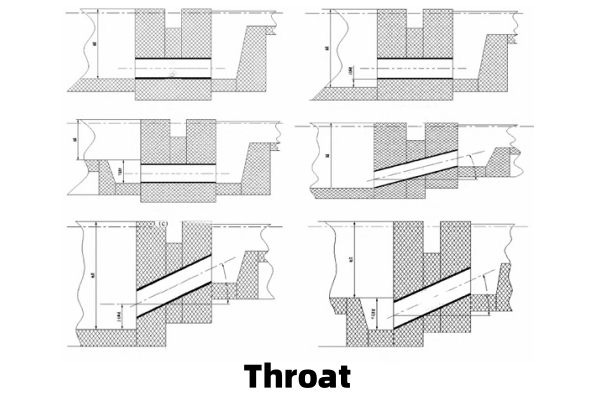

In addition to the forms shown in Figure, there are extended horizontal type, extended raised horizontal type, extended sunken horizontal type, extended inclined type, extended raised inclined type, and extended sunken inclined type, among others.
2.4 Materials for Reflux-Free and Maintenance-Free Throat
Since existing refractory materials cannot meet the requirement of zero erosion throughout the entire furnace cycle, the lining and accessories of reflux-free and maintenance-free throats must be made of high-temperature metal materials such as platinum and rhodium. The selection of high-temperature metals should be based on their physicochemical properties, characteristics, and cost-effectiveness. For all types of daily-use glass, the ideal high-temperature metal is platinum-rhodium alloy, but its high cost limits its application in the general glass industry. Only high-value-added specialty glasses use platinum-rhodium alloys.
The physicochemical properties of molybdenum fully meet the requirements of various glass types, but its biggest drawback is oxidation, which poses challenges in processing, structure, and startup. Currently, surface-treated molybdenum has no oxidation issues and can be used for the lining of reflux-free and maintenance-free throats.
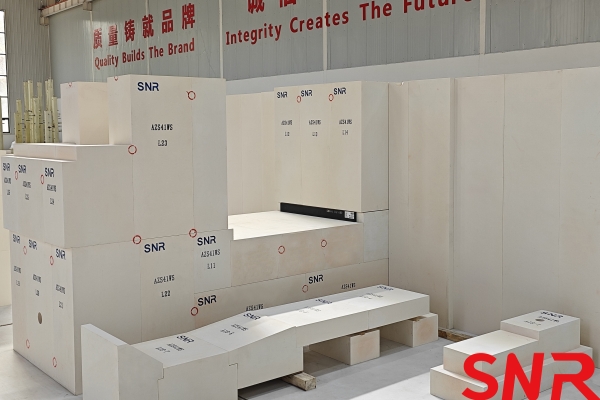

3. Operation of Reflux-Free and Maintenance-Free Throat
The key to operating a reflux-free and maintenance-free throat lies in the startup phase. First, the design must be reasonable, and the manufacturing must be precise. During transportation and installation, any scratching or bumping must be avoided to prevent damage to the anti-oxidation layer. Since the cross-section of a reflux-free throat is relatively small, measures must be taken to prevent blockages.
Once the throat is successfully put into operation, no maintenance or cooling is required (the front and rear walls of the throat should be cooled similarly to the sidewall bricks). No hidden dangers will exist throughout the furnace cycle.
3.1 Defects of Reflux-Free and Maintenance-Free Throat
Currently, reflux-free and maintenance-free throats have the following drawbacks: numerous design considerations, high difficulty and requirements for refractory material processing, challenges in manufacturing linings and accessories, high surface treatment requirements, and high costs.
3.2 Advantages of Reflux-Free and Maintenance-Free Throat
1 No Reflux: Throughout the production cycle, due to the non-eroding lining material (minor erosion can be ignored), the throat cross-section does not enlarge, and no molten glass reflux occurs under normal production flow rates.
2. No Maintenance: Throughout the entire production cycle, since the throat does not erode and its cross-section does not expand, no cooling or maintenance is required.
3. Long Lifespan: With reasonable design, high-quality manufacturing, careful installation, and accident-free startup, the throat‘s safe lifespan can match the entire furnace cycle.
4. Energy Savings and Reduced Consumption: Since there is no reflux, the molten glass does not require reheating, reducing energy consumption. The absence of cooling directly lowers investment and cooling power costs, eliminates temperature loss in the molten glass, and reduces heating losses in the working zone, achieving true low-carbon emissions. This is particularly significant for small-flow furnaces.
5. Stable Process: Since the throat does not erode, the extraction position remains fixed, the molten glass temperature stays stable, and process parameters require no adjustment, ensuring stable production and quality.
6. Easy Management: Once successfully started, the throat requires virtually no management, saving effort, labor, and costs.
Based on current operations, 50 m2 furnaces can fully meet the requirements of no reflux and no maintenance. Although the initial investment is high, the costs can be recovered through energy savings, stable production, and reduced management expenses during operation.
The prospects for reflux-free and maintenance-free throats are very broad. They are suitable for all glass furnaces with throats, especially small and medium-sized furnaces and electric melting furnaces.
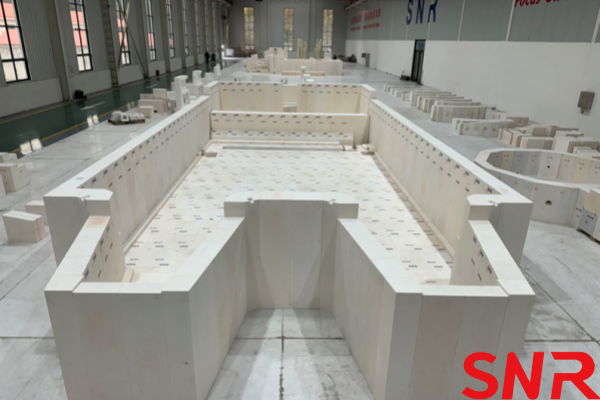

Henan SNR Refractory Co., Ltd. has been specializing in the production of fused cast AZS blocks for about 25 years. We use high-quality raw materials and advanced fusion technology to provide customers with high-quality products. From raw material procurement to finished product delivery, every step is strictly quality inspected to ensure that every indicator meets the standards, so you can use it with confidence.
 If you have any needs, you can contact me at any time.
If you have any needs, you can contact me at any time.
Web: www.snr-azs.com
Email: wendy@snrefractory.com


